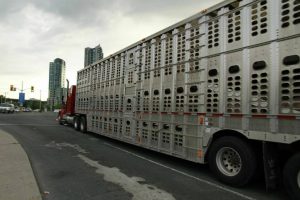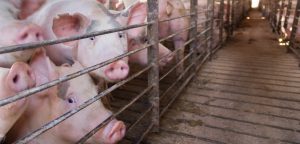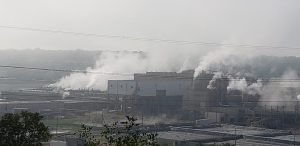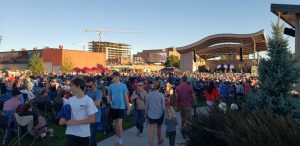The recently exposed plan to bring one or more additional slaughterhouses to Sioux Falls disappointed many in the community. Apparently, our hopes and aspirations for our city are very different than the elected officials and development officers who encouraged this direction.
Gloomy Vision of Our Future
I am a fourth generation Sioux Falls resident, with grandkids living in town. For me, quality of life in Sioux Falls should be the most important priority when evaluating growth opportunities. After all, not all growth is good growth. While that’s not a novel concept, it appears necessary to say at this point.
I am surprised that some city and state leaders, as well as economic development officials, think bringing more slaughterhouses to town is a good idea. They have reportedly been working behind the scenes for years to accomplish this. It suggests to me that they have a pessimistic view of the future of Sioux Falls.



North of downtown Sioux Falls
Slaughterhouses are a horrible fit for our community. Affordable housing and workforce availability are already huge concerns. The idea of adding lots of difficult, low-paying, low-skill jobs, the type that have traditionally been a drag on our progress and success, makes no sense to me. And expanding the presence inside our city of an industry which has long caused pollution problems in our river and air makes no sense. I simply don’t understand why we would want more of this in Sioux Falls.
Imagining a Better Sioux Falls in the Future
I have been involved in the creation of countless strategic plans for organizations and groups in Sioux Falls and elsewhere. That experience has taught me the incredible power of an inspirational vision of the future. Organizations that imagine a better tomorrow, and take steps to head there, often end up successful. Our city could too.
Unfortunately, it appears that some city and state leaders have not embraced a positive vision of the future of our community. I am thankful the voters in Sioux Falls are insisting on a chance to tell them they are wrong. They will get a chance in November to say no to more slaughterhouses. We want our city to continue to improve, and not head the other way. We can be much better than our leaders apparently think we can.
Here, for example, is a more inspirational vision of our future.
Sioux Falls 2032

Sioux Falls has a good thing going. It is a great place to live, work and raise a family. It is a wonderful community with great potential to be even better.
- Focus on Quality of Life – Recognizing that heavy industry which produces noise, air or water pollution has no place in our urban community, we will use zoning laws and other available tools to discourage that while encouraging positive growth.
- Become One Sioux Falls – We will work to unify our metro area government into one city government, one school district and one county.
- Increase Wages –We will strive to raise our median household income to the national average (we are currently 5% behind) by attracting higher paying jobs.
- Reduce Poverty – We will significantly reduce the percentage of children in the Sioux Falls School System qualifying for free and reduced-price lunch.
- Increase Teacher Salaries – We will pay our teachers at a rate comparable to at least the 40th place state in the US.
- Expand Preschool Programs – We will significantly increase the percentage of kids attending preschool programs.
- Enhance Downtown – We will devote more energy and resources toward making this centerpiece of our community even better for businesses, residents, workers and visitors.
- Expand the Arts Community – Building on the success of the Pavilion, Levitt, Sculpture Walk and much more, we will continue to enhance our arts community.
Of course, this is only a partial list, and many other topics need to be covered. And the targets I picked are arbitrary. However, this list suggests the type of vision our community leaders could articulate.
Big Picture Planning
Granted, the city does a lot of planning. It has a parks plan, a capital spending plan, a downtown plan and much more. But I am not aware of any sort of comprehensive plan for our city with direct participation of the mayor and council. In support of that, some council members and candidates have told me they wished they could be involved in that sort of big-picture, strategic planning. If there was such a plan, I doubt it would have included the phrase, “add more slaughterhouses”.
These are some off the cuff ideas of what a more optimistic vision for our city might look like. They are just my ideas, and I am not proposing them to anyone. But I wish state and local elected officials supporting more slaughterhouses inside city limits would reevaluate their depressing visions for the future of our community. Sioux Falls is not a factory town, and it doesn’t want to become one.
There appears to be a comprehensive community planning effort forming. Check out this article from “Chamber News:” https://siouxfallschamber.com/long-range-strategic-plan-will-seek-community-input/
From the article:
“Forward Sioux Falls is leading collaboration with the City of Sioux Falls, Sioux Falls Area Community Foundation, Sioux Empire United Way and the Sioux Falls Public School District.
“RDG, an Omaha-based consulting firm, has been hired to coordinate the plan, which will focus on quality-of-life attributes including, but not limited to:
Arts/Entertainment/Recreation/Leisure
Education/Training/Workforce
Health & Human Services
Housing
City Image/Marketing
Public Safety
“A plan to engage the public in the project has been designed and will be implemented later this summer. This will include surveys, listening sessions, community roundtables and open houses. In addition, there will be opportunities for community members to participate and provide input during existing events held throughout Sioux Falls to meet people where they are.”
Joe; a personal thank you for your involvement and commitment to our community, your mark is permanent and indelible and I look forward to your continued vision. I am not aware of any work behind the scenes to bring or incent Wholestone Foods to our community. Several years ago land was rezoned to be used for industrial use and Wholestone purchased that land and has plans to build a plant that is quite dissimilar from the Smithfield plant in technology, processes, and the amount of undesirable environmental impact to the community. Part of their plant is a $35 million waste water treatment facility so that they don’t have to rely on the municipal wastewater treatment plant. It is a food processing facility that is NOT owned by China, but the local farmers and producers that live within a short distance of Sioux Falls. Changing the rules after a company complies with all the requirements that are set forth is a scary precedence and one that will not go unnoticed by other “more desirable” industries that will view our community as having too much risk to consider for their investments. A new slaughterhouse is not in my list of chosen industries, but the road we are going down with the ballot is fraught with pot holes and unintended consequences.
I prefer to call Wholestone a “food factory” …one with modern state of art technology. Ag is still our state and region’s number one industry. The current meat processing industry is controlled by four large companies who have upwards of 80% market share. Two of those players are foreign owned: Smithfield & JBS. Our nation, state, and region is not well served by such limitations; Sioux Falls would be wise to go the extra mile in support of local, farming ownership…. It’s too easy to say NIMBY (not in my back yard). Let’s go beyond the identification of a problem. Let’s work together and find a mutually beneficial solution…. Personally I believe the location chosen can be made quite workable. Dale Froehlich
Thanks for this post. It prompted me to reflect upon the terms “growth” and “development” which are often conflated. I think that there’s frequently danger in this linguistic confusion..
Growth is a QUANTITATIVE (objective, empirically measurable to large degree) concept. In terms of social systems, capitalism (a system predicated upon profit-seeking) is propelled by growth. Growth is the “engine” of capitalism. In other words, sans growth, capitalism is “dead.;” a clunker sitting on blocks in an abandoned driveway merely rusting away. Development is a QUALITATIVE concept (mostly subjective, most often not directly amenable to measurement.) A social system other than capitalism can develop without growth. However, sensible growth almost certainly makes development more easily achievable. But growth is not inherently healthy (or toxic.) Social systems other than capitalism can (and have) embraced growth.
My use of the phrase “sensible growth” is inherently subjective. My conception of sensible growth might be construed as quite nonsensical (nonsensible?) to other citizens. Free and open discourse among the citizenry is thus necessary to achieve some sort of compromise in that arena. I appreciate forums such as this blog and all others which promote debate/deliberation with respect to the “public purpose.”
Let’s consider a simple and homely little example. If a family’s real income increased last year, that is surely representative of growth. If those extra resources afforded that family the ability to enjoy things previously unattainable (higher education, music lessons, art classes, more time to volunteer, a first “real” vacation, participation in sports as an observer or participant, etc.) it’s likely that a lot of development occurred. Admittedly, development is at least a bit “fuzzy,” but the opportunity for people to more fully participate in, and to enjoy what it means to be human is surely development (for individuals and their communities.) But growth does not assure development. Most of us probably know of situations where greater family “prosperity” led to rupture rather than rapture.
In red-state South Dakota, the mantra of “free markets” is ever present. Rants against government, taxation, regulation, etc. often fuel hollow political sloganeering. But markets are/were never free (aside from within models presented in elementary economics courses where market outcomes are invariably shown to be optimal, with rare exceptions.*) In the “real world” (from which SD is not exempt, despite what some might think/wish,) markets are often (usually?) manipulated via entities which have the power to do so. As Isaiah Berlin once noted,“Freedom for the pike is death for the minnow.” Yet anyone who points this out as obvious is declared a socialist, a commie, a lib; surely not a patriot and clearly not suitable for elected office. Ironically, these utterances often emanate from those drinking with gusto from the” public trough.”
I hope we have not moved beyond a point where citizens of Sioux Falls no longer have a “say” with respect to the kind of community we wish to develop (and almost certainly, but not inevitably, to grow.) Shall we remain an “Ordinary Town” (props to Dave Carter & Tracy Grammar’s opening cut on their Drum Hat Buddha album) or should we aspire to something beyond the ordinary? Joe has made his position very clear. I tend to agree with him. That said, I suspect that Joe’s positions and mine would often be at odds. But I don’t know that to be true and could be wrong. I’ve aspired to always remain mindful of the reality that I could be wrong in my thinking and that changing my mind upon discovery of such is not failure. I appreciate the civil discourse thus far exhibited on this blog. That’s a scarce commodity these days.
*NB: I was an economics professor (recently retired) at four universities over the course of forty years. Although size, quality and “mission” of institutions varied greatly, the core economics curriculum did not. Apologies if it seems like I’m offering a lecture. The “old dogs, new tricks” problem rears it’s head yet again.
Readers of this blog post might be interested in the Citizen Planning Academy run by the City of Sioux Falls: https://siouxfalls.org/planning-dev/planning/academy.